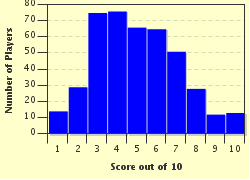Quiz Answer Key and Fun Facts
1. It's a belt loop, but it's the special belt loop that holds the end of the belt in place to stop it flapping about. What is this whatchamacallit called?
2. Your bottle of wine has fallen over and you can see the dent in the base. This whatchamacallit, the dent, is actually called a what?
3. Most of us have ten of these, some larger than others. It's the white area at the base of your nails. This whatchamacallit gets its name from its shape which can resemble a heavenly body. What is the name of this whatchamacallit?
4. Avast, me hearties! This pirate is wearing a baldric. You might call it a whatchamacallit, but 'baldric' is another name for what part of his ensemble?
5. When you close your eyes tightly, you can see spots, sparkling lights or other patterns. Unsurprisingly, these have a name, a name derived from the Greek words for 'light' and 'show'. What is this whatchamacallit or light display called?
6. These whatchamacallit rays are called crepuscular rays. The adjective crepusucular comes from the the Latin 'crepusculum!' which means what?
7. You're staring at a map trying to work out where you are and how to get from point A to point B. On the map is a whatchamacallit with an arrow and the words 'You are here'. What do you call this handy indicator?
8. Turkeys are funny looking creatures. Between the whatchamacallits on their heads or under their beaks, they really do look like they got dressed in a hurry and in the dark this morning. That watchamacallit draped over its head (indicated with arrows) is really called a what?
9. You've most likely seen a collection of typographical symbols like the photo in a cartoon. Used to substitute for curse words in a cartoon, it can indicate anger or surprise. You can't keep calling it a whatchamacallit, so what is that collection of symbols called?
10. Now that we're at the end of the quiz, it's time to celebrate with some champagne. I need to open up the umm... the whatchamacallit... the wire around the cork. There is a name for the wire, but there's no celebrating until I know what it is. What is the proper name for it?
Source: Author
Tizzabelle
This quiz was reviewed by FunTrivia editor
LadyCaitriona before going online.
Any errors found in FunTrivia content are routinely corrected through our feedback system.

